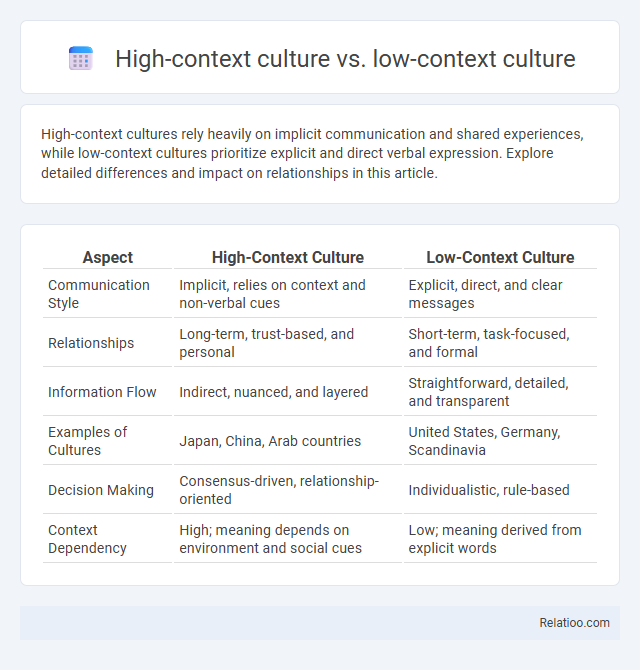High-context cultures rely heavily on implicit communication and shared experiences, while low-context cultures prioritize explicit and direct verbal expression. Explore detailed differences and impact on relationships in this article.
Table of Comparison
| Aspect | High-Context Culture | Low-Context Culture |
|---|---|---|
| Communication Style | Implicit, relies on context and non-verbal cues | Explicit, direct, and clear messages |
| Relationships | Long-term, trust-based, and personal | Short-term, task-focused, and formal |
| Information Flow | Indirect, nuanced, and layered | Straightforward, detailed, and transparent |
| Examples of Cultures | Japan, China, Arab countries | United States, Germany, Scandinavia |
| Decision Making | Consensus-driven, relationship-oriented | Individualistic, rule-based |
| Context Dependency | High; meaning depends on environment and social cues | Low; meaning derived from explicit words |
Introduction to High-Context and Low-Context Cultures
High-context cultures rely heavily on implicit communication, nonverbal cues, and established social relationships, making understanding subtlety and context essential for effective interaction. Low-context cultures prioritize explicit verbal communication, clarity, and directness, minimizing the need for reading between the lines. Your cultural background shapes how you interpret messages, influencing your ability to navigate between high-context and low-context communication styles.
Defining High-Context Culture
High-context culture relies heavily on implicit communication, shared experiences, and non-verbal cues to convey meaning, making understanding dependent on the cultural background of the participants. Common in societies such as Japan, China, and Arab countries, these cultures emphasize relationships, social hierarchy, and collective values. In contrast, low-context cultures like the United States, Germany, and Scandinavian countries prioritize explicit, direct communication where clarity and precision reduce ambiguity.
Understanding Low-Context Culture
Understanding low-context culture involves recognizing communication that is explicit, direct, and relies heavily on spoken or written words rather than situational cues. In contrast to high-context cultures, where meaning is often derived from context, relationships, and non-verbal signals, low-context cultures prioritize clarity and precision to avoid misunderstandings. Your awareness of cultural background helps navigate these differences, ensuring effective interaction in diverse environments.
Key Differences Between High-Context and Low-Context Communication
High-context communication relies heavily on implicit messages, non-verbal cues, and shared cultural knowledge, common in cultures such as Japan, China, and Arab countries. Low-context communication emphasizes explicit, direct verbal messages with little background information, typical in the United States, Germany, and Scandinavian countries. Understanding these differences is crucial for effective cross-cultural interactions, as misinterpretations arise when communicators apply their cultural norms to contexts requiring opposite communication styles.
Examples of High-Context and Low-Context Societies
High-context cultures, such as Japan and Saudi Arabia, rely heavily on implicit communication, non-verbal cues, and shared experiences to convey meaning, reflecting deeply rooted cultural backgrounds. In contrast, low-context societies like Germany and the United States prioritize explicit, direct communication where information is spelled out clearly to avoid misunderstandings. Understanding these distinctions helps you navigate cross-cultural interactions effectively, respecting each society's communication style.
Impact on Business and Workplace Communication
High-context cultures rely heavily on implicit communication, nonverbal cues, and shared experiences, which can lead to misunderstandings in diverse business environments if not properly navigated. Low-context cultures emphasize direct, explicit communication, promoting clarity but sometimes at the expense of relational nuance and trust-building. Understanding cultural background is crucial for multinational organizations to tailor communication strategies, enhance collaboration, and improve negotiation outcomes across varying cultural contexts in the workplace.
Challenges in Cross-Cultural Interactions
High-context cultures rely heavily on implicit communication, nonverbal cues, and shared experiences, which can create misunderstandings for individuals from low-context cultures that prioritize direct and explicit information. Your ability to navigate these differences is often challenged by varying cultural backgrounds, causing potential misinterpretations and communication breakdowns. Recognizing the influence of context on conversation styles enhances cross-cultural interactions and minimizes conflicts.
Strategies for Bridging High- and Low-Context Communication Gaps
Understanding high-context culture emphasizes implicit communication and relying on shared experiences, while low-context culture values explicit, direct verbal messages. Strategies for bridging communication gaps include active listening, seeking clarification, and adapting your communication style to accommodate cultural background differences. Employing culturally sensitive feedback mechanisms fosters mutual understanding and reduces misinterpretations between high- and low-context communicators.
Case Studies: Real-World Applications
High-context cultures, often found in Japan and Arab countries, rely heavily on implicit communication, non-verbal cues, and shared experiences, impacting negotiation styles and business etiquette in multinational companies. Low-context cultures, prevalent in the United States and Germany, emphasize explicit, direct communication, facilitating clear guidelines and contracts in international trade agreements. Case studies from cross-cultural business ventures reveal that understanding these cultural backgrounds improves conflict resolution, enhances team collaboration, and increases success rates in global operations.
Conclusion: Embracing Cultural Diversity for Effective Communication
Understanding high-context and low-context cultures helps navigate communication nuances shaped by your cultural background, ensuring clearer interactions. Embracing cultural diversity enhances empathy, reduces misunderstandings, and fosters collaborative environments. Adapting your communication style to different cultural contexts ultimately leads to more effective and meaningful connections.

Infographic: High-context culture vs Low-context culture
 relatioo.com
relatioo.com